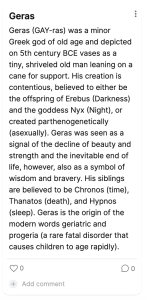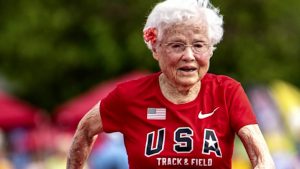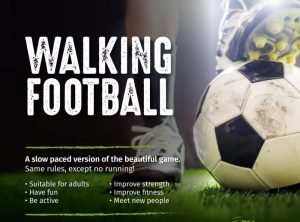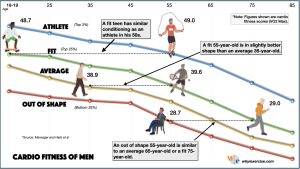6
Section One: The Fundamentals
A) Keywords
Exercise 1:
Provide a brief definition of one of the padlet keywords for this week.
 |
B) The Social Significance of Aging in Sport
Exercise 2: Notebook Prompt
How is old age popularly represented today? Find an image online that you think exemplifies one defining attitude towards old age and paste in your notebook below with a brief explanation of what this image means to you.
| Old age is relative, I had a niece who at 19 honestly felt her life was over and all downhill from there on. I’ve also known people who seemed 80 at 50, and others who came across as 50 at 80, to say nothing of those like Deolira da Silva who just celebrated her 120th birthday, or Hurricane Hawkins below who just won a 50m race at 103:
How age is popularly represented varies based on both physical age and chronological period (The “X” Age). The Third Age is retired seniors who are still living active healthy lives. Third Agers are often portrayed as wise, content, active, happy, capable, and still sharp. Those in the Fourth Age are experiencing declining health and related issues and are more socially detached. The Fourth Age is also nearing the end of the circle of life and is a period of marked physical and cognitive decline. Much like infants, Fourth Agers are often depicted as frail, weak, innocent, and childlike.
|
Exercise 3: Notebook Prompt
What does the article (referencing another study by Dionigi) mean by its statement that sport can help aging people to simultaneously “accept and resist the ageing process” (572)? Respond by audio or text and find paste two images sourced online into your notebook showing how sport might help aging people to both accept and resist the aging process.
| Acceptance of the aging process is observing the performance of your body compared to your younger years: slower runs, less body strength, less coordination, speed of cognition, agility, etc. By staying in sport, seniors can “maintain their sense of physical competence” (Pike, 572). Resistance falls under strategies to reverse aging; physiologically, pharmaceutically, lifestyle/diet, etc. Sport belongs to the physiological realm; increasing/maintaining aerobic capacity, strength training, coordination/agility, etc.
Walking Football
Performance Over Time |
Exercise 4: Notebook Prompt
Who are the groups less likely to have extensive opportunities to take part in sports, according to Pike? How does privilege factor into aging and sport? (200 words max)
| Elizabeth CJ Pike identifies a number of groups of older persons with access issues: “those with disabilities, the very frail, some minority ethnic groups, those confined to care facilities and those living in rural areas” (Pike, 572). To these could be added others like certain diseases, reduced mobility, psychological issues such as mental decline (triggering lower motivation), financial/economic barriers, and those experiencing quality of service issues (i.e. non-inclusive attitudes).
Pike considers sport and aging a complex issue. While on one hand older persons have almost unlimited time available to engage in sport, many factors such as those above can neutralize this advantage. Privilege is surfaced in aging and sport in a number of ways such as race (systemic barriers), gender (patriarchal environments), sexual orientation, religion (i.e. older Muslim women), ability (higher cost of program delivery), age (inaccurate perceptions, fewer programs), and socioeconomic status (the ability to pay for sport programs, acquire regular transportation to programs, the greater availability/quality of programs in higher cost care homes, etc.).
|
Exercise 5: Padlet Discussion
Why do you think age discrimination is “reported more than any form of prejudice” with older people presented as a threat to social values and interests? Feel welcome to use video in your responses. Paste your comments (or transcript of your video) below!
|
Age discrimination is highly prevalent because it hasn’t had it’s moment yet. Race, gender, and class, have all had social revolutions raising awareness and rearchitecting society in their wake. Whereas these revolutions have been empowered to allow discriminated segments of society to create equitable and rewarding lives, those in the elderly segment have already lived their wage-earning lives and the urgency for equity and justice is considerably lower. Ashton Applewhite’s short video is a great overview, especially her descriptive examples of magazines and greeting cards. The threat referred to relates to seniors being viewed as an unproductive economic burden by neoliberal theory.
|
B) Older Women and Sport
Exercise 6: Notebook Prompt
What differences do you see in these ads? Which one is more inclusive? How is age represented or not represented in each? Answer these questions in your notebook.
| I love these ads. I’ve always been inspired by Nike’s ability to frame emotion in sport, and This Girl Can reminds me of why I originally became involved in women’s sport. Men’s sport is powerful, faster, more lucrative, and ego-based, but women invest more emotionally in sport and I’ve always found it rawer and more infectious.
As identified in the reading, the Nike ad is of course less inclusive by focusing on youth and body ideals, with the second ad more “real” by including a wider and fuller spectrum of women (well, cis-gender women). The official 90-second version of the This Girl Can ad, which is set to Missy Elliot’s Get Ur Freak On is pretty good too, and carves out more of a middle ground between the two (Nike and This Girl Can). It was the first time Elliot licensed her music for commercial use: |
Exercise 7: Notebook Prompt
In her article, “Assessing the sociology of sport: On age and ability,” Elizabeth Pike references a “trend towards a ‘feminisation of ageing’, with many women living longer than men” (573). Do you agree that aging has been “feminized” in this way? How? Answer these questions in your notebook.
| Yes, there has been a feminization of aging. For Canadians over 65 there are only 0.75 males per female, and over 85 it declines to under 0.50. Women live longer than men due to a combination of physiological, sociocultural, and lifestyle choices. This imbalance has ramifications for how aging is represented, as communications and marketing concerning the elderly becomes market-driven to reflect these ratios. For example, I did a search in Google images on “seniors ad” and scrolled 500 images. Where there was only one biological sex present in the search result (i.e. a man or woman, not a group of people), I recorded which one and kept a running tabulation. Women outnumbered men three to one.
|
Section Three: Module Mini Assignment
| Part 1: Using the Pike article in Section One as a reference, analyze popular depictions/discussions/critiques of pickleball as a “sport trend” that has proved enormously appealing to older segments of the population.
Pickleball is having a moment. Despite its exploding participation and trendy media coverage, pickleball is regularly discredited, polarizing, and ageist. Pickleball is North America’s fastest growing sport the past few years, with over 13 million players in the U.S. and one million in Canada (6, 2). It has grown over 200% the past few years (6), with over 10% of households having a player (5), and females growing at over 50% per year (2). To seniors it is “youthful and hip” (3), and more of a lifestyle than a sport to players (9) (my 60 year-old little sister texts me about her games almost every day in-season). I was not surprised at all seeing 2,764 comments about a post on it while researching. But this boom comes with plenty of detractors and is “gaining haters almost as fast as players” (2). These include that it is not a sport (1, 2, 4), not good exercise (1), is destroying tennis (9), it’s noise is traumatizing (1, 2, 9, 11, 12), etc. Like politics, gender, and religion, pickleball is polarizing: you either love it or hate it (9). Pickleball’s roots are inclusive, it was originally intended to be fun and accessible (8, 9). Although it has been adopted by seniors due to it’s more limited physical requirements (1/2 regular players are over 55, 1/3 over 65), it is gaining a younger footprint. The average player is 38, a three year decrease over the past few years (10). The current world champion is 16 (13), and the 18-34 age group represents 34% of casual players (4), with communities like Calgary unable to keep up with court demand due to the growth in younger age groups (7). However, despite its considerable youth segment, pickleball is still largely seen as an “old person’s sport,” preventing the serious recognition it deserves. What should be framed as a great proven social and health outlet for everyone (including the elderly) (2, 8, 10), is instead viewed from a negative/nuisance perspective due to historical sport/youth bias. 1. https://www.washingtonpost.com/opinions/2023/05/08/pickleball-hate-reasons/
Surface problems: noise, environmentalism, lack of consultation, nature of the park (1). All of these arguments have been ably defeated by The Narwahl and the City (2, 3). Underlying problems: NIMBY-ism, ageism. Decades ago these parks were alive with the sound of bats cracking, people screaming instructions and cheering, and post-game festivities and beverages (and the odd fight) in the parking lots. However, community baseball has become an endangered species and ball diamonds in cities all over the country have cobwebs. Most residents protesting in the communities affected have not lived there for decades and their only context is an empty greenspace. Which was never the intent for the parks or space and their emptiness has created a sense of entitlement. Community parks are not libraries. Outdoor hockey rinks have slap shots crashing into the boards, base/softball home runs, players and supporters shouting, etc. Urban houses beside a park with sport facilities are not in Sleepy Hollow. What is missing in the debate is the ongoing lack of opportunities for the elderly in sport. This is rarely mentioned and is clearly not on anyone’s mind. There are always plenty of outdoor rinks, soccer fields, basketball courts, etc. for people 5-65 to play in. Given the benefits of sport for the physical and mental well-being of older people and our health system, society should be going out of its way to expand facilities for seniors. It should be a key factor in the debate and yet is not even in the equation, which indicates seniors health benefits are secondary to the interests of others. What is surprising is the evidence of horizontal hostility, or internalized oppression. In every photo and video reviewed, the clear large majority of protestors have grey hair. It is seniors vs. seniors. Perhaps all the homeowners in the area are retired seniors who were shunned in a relationship by a Pickleballer, but my spider sense is telling me someone whipped the residents of the Marycrest seniors home across the street into a mobilized frenzy. It’s always sad to watch marginalized groups cannibalize themselves, especially given the greenspace the home has, as well as access to Jackson Park. 1. https://thenarwhal.ca/opinion-peterborough-pickleball-paves-park/
|




